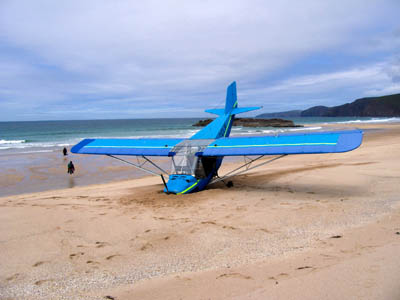A microlight plane pilot had to resort to muscle power to retrieve his aircraft after it crash landed on one of Britain’s remotest and most environmentally sensitive beaches at the weekend.
Pilot Keith Brown escaped unscathed when his plane ended up with its nose embedded in the beach at Sandwood Bay after a manoeuvre went wrong. The area is owned by the John Muir Trust, which takes a dim view of any motorised use of the 6km (four-mile) track leading to the Sutherland beauty spot.
Mr Brown decided to enlist the help of 13 of his colleagues and dismantled the plane before carrying the parts the 6km for storage in a shed at the nearest croft.
The pilot’s day had taken a turn for the worse on Sunday when he tried to touch his wheels on the sands during a flight round the headland. Unfortunately for him, the soft sand meant his wheels got bogged down and his craft came to a shuddering halt. Luckily, he was travelling slowly and he walked away from the craft uninjured.
Conservation manager for the Sandwood estate Cathel Morrison said: “The sand dunes around Sandwood are very fragile and this is a very sensitive time for breeding birds such as skylarks and meadow pipits.” Hence the ban on bringing vehicles to the beach.
So it was out with the spanners for the pilot and a call for help to his 13 burly plane transporters to carry the fuselage, wings and engine back to the car park.
Crofter Cathel Macleod’s shed is temporary home for the dismantled aircraft before it is transported back to its base in Bedfordshire for reassembly.
When quizzed by John Muir Trust staff if he had insurance for his microlight, Mr Brown quipped: “Yes, but it doesn’t cover crash landing on a beach.”
In addition to Sandwood Bay, the JMT also owns much of Ben Nevis, Schiehallion, Quinag and the Red Cuillin on Skye.

Gary Sutherland
25 June 2009Keith Brown was lucky to recover his aircraft.
The last plane to land on Sandwood beach is still there - a 1941 Spitfire, the remains of which can still occasionally be seen poking through the sands at low tide.
Jhimmy
25 June 2009Never mind the aircraft, JMT was lucky to save the beach.
What the JMT really was worried about was the aviation fuel, engine oil and hydraulic oil polluting the sand. If the sea had reached the plane the oils would have spread. This would have been serious as only a small amount of fuels/oil can spread hundreds of metres.
All would have had to have been bagged and disposed of and that's not accounting for any wildlife with fuel on their feathers/skins. Not sure who would have been responsible for the cost, but it'd be expensive.